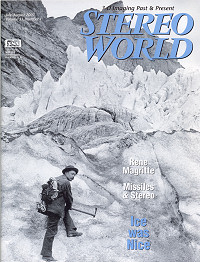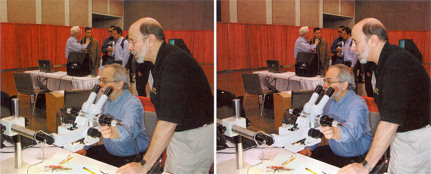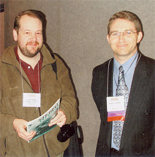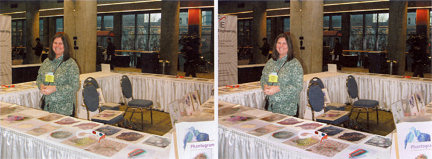
2007 Proceedings
2007 Photos
|
Download the printable pdf version of this article. (960kB)
and is reprinted here with kind permission of the National Stereoscopic Association.
Stereoscopic Display Conference by Lawrence Kaufman
|  |
While some form of the Stereoscopic Display conference has been around for over two dozen years, I have only been attending bits and pieces for the past ten. In the past I have always tried to get there for at least the display demonstration session (which is usually free,) [A fee to attend this session applies from 2008] the stereoscopic video 3D theater session presentation and the keynote address if possible. This was the first year that I could take advantage of the invitation to cover the entire event for Stereo World. Past conferences have been covered by Steve Berezin (Stereo World V29 #4) and Ray Zone (Stereo World V31 #5)
Press credentials certainly beat the several hundred dollar entrance fee, but who can put a price on a glimpse into the future? This is where there is the greatest concentration of information about stereoscopic displays and their future. The conference once was held in conjunction with the Photonics West show, but the crowd grew too large and now the display conference is being held the week following Photonics West, which features an interesting trade floor of its own.
The day prior to the conference, there was an educational short course held that requires an additional fee. This year the course was Stereoscopic Display Application Issues. The conference itself is nicely divided into a dozen sessions with several presentations under each session and the time moves by quickly. Monday morning saw session 1 "Stereoscopic Display Applications" and session 2 "Medical Applications of Stereoscopy." After lunch session 3 was "Stereoscopic Image Processing and Intermediate View Reconstruction," session 4 examined "Stereoscopic Human Factors." Another break and it was time for the 3-D Theater. Unfortunately there was a slight problem with the sound during most of the presentations. But this misfortune turned out to have a silver lining, since many of the 3-D videos were replayed during the breaks of the remainder of the conference.
Two Hour 3-D Theater Session
Shown during the 2007 SD&A conference 3D Theater session were:
• "June" by National Film Board, Canada
• "Loop.. 3D adventures of a solution provider" by Fast Forward with Carlo-Magno (Italy)
• "I am Calling You - Backstage" by Fast Forward with Carlomagno (Italy)
• "Mayavi" by GV Films Ltd (India)
• "Test Piece 01" by Takashi Kawai and Kei Shichiri (Japan)
• "Visionsense Stereoscopic Endoscopy" by Visionsense (lsrael and USA)
• "Pompei 79AD" by Virtualand (Italy) "Death Valley 3D Daze" by Tree-D Films (USA)
• "Alertness Matters" by Hall Media (USA)
• "Fluffies" by ACE a.s. (Czech Republic)
• "Pool Shark" by Neil Alexand and GALl-3D (Czech Republic)
• "Pig Story" by Secondary School of Applied Cybernetics and GALl-3D (Czech Republic)
• "St Valentines Shoe" by Secondary School of Applied Cybernetics and GALl-3D (Czech Republic)
• "Real Time OPENGL stereo capture to file" by GALI-3D (Czech Republic)
• "Space Station in 3D" by European Space Agency (Netherlands)
• "Born of a Car" by Skoda Auto Multi-media team and GALl-3D (Czech Republic)
• "The Time of Illusion" by NHK Technical Service (Japan)
• "FlFA World Cup Trophy Tour" by Haptics (South Africa) and Crew 972 (Israel)
• "Lenny Lipton and Ray Zone at World 3D Expo II" by 21st Century 3D (USA)
• "Humira 3D" by 21st Century 3D (USA)
• "Avandia 2006" by 21st Century 3D (USA)
• "3DVX3.5 Live Action Demo 2007" by 21st Century 3D (USA)
• "Mitsubishi Outlander" by BUG Norway
• "World of 3D" by Lightspeed Design Group (USA)
• "lntelIigent Vehicle Safety" by Lightspeed Design Group (USA)
• "DSVclips"byLightspeed Design Group (USA)
• "'06 The Big One" by Bernard Mendiburu (USA)
• "Home of the Blizzard: The 1911-14 Australasian Antarctic Expedition Stereoscopic Photographic Record" by Peter Morse, University of Western Australia (Australia)
• "New York City in 3-D" by Jeff Joseph / SabucCat Productions (USA)
The winners: as judged by Dr Samuel Zhou, Director of Image Technology, IMAX Corporation.
• Best Live Action 3-D film: "The Time of Illusion" by NHK Technical Service (Japan)
• Best CG 3-D film: "FIFA World Cup Trophy Tour" by Haptics (South Africa) and Crew 972 (Israel)
Following the theater session, the majority of attendees walked to the nearby BoTown Chinese Restaurant for an annual tradition - the SD&A dinner, a no-host informal affair which gives you a chance to make new friends and discuss the day's events.

| The 3D Consortium showcased stereoscopic products from member companies. David Mark from Mark Resources demonstrated a 22 inch LCD autostereoscopic display monitor with a diagonal parallax barrier creating seven views for 3-D viewing, and a 60 inch diagonal full-color 3-D back-lit transparency print with 30kx40k resolution showing a collection of fluorescent minerals. For3D showed three stereoscopic monitors from Pavonine of South Korea. Stereo by Lawrence Kaufman (wall-eye stereopair) |

| It was back to Wheatstone for Imprint Interactive Technology of Seattle,with their digital stereoscope system based on two LCD panels and mirrors with a VR demonstration application. Stereo by Lawrence Kaufman (wall-eye stereopair) |
Plenary Sessions
Day two and day three began with plenary presentations which were open to the entire Electronic Imaging symposium. In fact the "technical program" for the symposium is a thick 216 pages - larger than many small town phone books. The plenary presentations were naturally held in a very crowded large ballroom. On day two Brian A. Wandell from Stanford University discussed "Development and Plasticity in Visual Cortex."
Even more interesting were the two presentations on day three, first Francois Blais, National Research Council of Canada presented "More than a Poplar Plank: The Shape and Subtle Colors of the Masterpiece 'Mona Lisa' by Leonardo." This was an in-depth look at a scientific examination of the Mona Lisa, including a 3-D digitization (3D imaging) of the painting. The Second session was "Space Exploration, Imaging Technology, and the Development of a Virtual Presence in Space" by Eric M. De Jong, Principle Investigator, Solar System Visualization (SSV) Project. This was a very interesting up to the minute presentation on the history of Space Exploration and included the current stereo visualization. I had heard De Jong on at least two previous occasions once at a Society of Motion Picture and Television Engineers (SMPTE) meeting and at NASA's Jet Propulsion Laboratory (JPL). At the two previous talks, the presentation had included stereo imaging, so as interesting as this was, it seemed a little flat. De Jong was a co-author of "NASA's STEREO Mission" (Stereo World V32 #1) It was nice also to later see De Jong sitting in the day 3 sessions.
More Stereo Display Sessions
Day two included session 5 "Stereoscopy on Mobile Devices," session 6 "Multiview Content," Session 7 "Autostereoscopic Displays," and session 8 "Stereoscopic Developments," before moving into the SD&A Demonstration Session. The Demo session, as I stated earlier, is one of my favorite parts of the conference. Over the years I have seen many amazing items. Some are now currently available, some are still being developed, others have come and gone and others have never been heard of again. The Demos have become so popular that they now include the entire EI conference symposium and the papers are also posted in the room. A partial list of presenters can be found later in this article and at www.stereoscopic.org/2007.
Day three included session 9 "Crosstalk in Stereoscopic and Autosteroscopic Displays," a panel discussion on "3D in the Home: How Close are We?," session 10 "Stereoscopic Video," Session 11 was the Keynote Presentation. The day and the conference ended with session 12 "Integral 3D Displays." Session 13 "Virtual Environments: Implementation" (which included "Three-dimensional cameras on the International Space Station") and session 14 "Virtual Environments: The Experience."

| Mike Weissman (seated) from TrueVision Systems demonstrates TrueVision, a real-time HD 3-D video camera system for stereomicroscopes to an unknown conference attendee. Live microstereoscopic video was displayed on a Planar StereoMirror stereoscopic display. Stereo by Lawrence Kaufman (wall-eye stereopair) |
The discussion forum "3D in the Home: How Close are We?" moderated by Lenny Lipton, CTO, Real D was a fun and lively discussion. The panel included Brett Bryars, United States Display Consortium; Art Berman, Analyst, Insight Media; Mark Fihn, Publisher, Veritas et Visus/3rd Dimension Newsletter and Steven L. Smith, CEO, VRex Inc. The panel shared their thoughts and then opened it up to questions from the audience, finishing with their predictions for when we would have 3-D in the home. Mark Fihn had opened by saying that even though he has television devices in his home, he and his wife do not watch regular TV. His prediction was 2010 for "his" home. Lipton's optimistic prediction "this year" was based on the fact that he is an avid reader of Popular Science and anything they discuss is doomed. But since they have not discussed 3-D TV, he feels very confident that it will roll out soon.
The Keynote Presentation was "A Look at the Past and Future of Stereoscopic Displays Through a (Liquid) Crystal Ball" by James Ferguson of Ferguson Patent Properties was more of a look back at the beginning of liquid crystal displays than the future. But James Ferguson was the single most important individual to lead this discussion. He holds 130 U.S. patents and his inventions form the foundation of the multi-billion dollar liquid crystal display industry.
Other Highlights
Andrew Woods discussed the project he lead testing a wide range of consumer DLP projectors to determine their level of compatibility with stereoscopic display using liquid crystal shutter (LCS) 3-D glasses. At the end of the project they had tested 44 consumer grade Single-chip DLP projectors. They found fifteen that work well at up to 85Hz stereo in VGA mode. See his website for details: www.3dmovielist.com/projectors.html.

| Chris Ward of Lightspeed Design Group (holding a sample Stereo World at left) chats with co-chair Andrew Woods during a break between sessions. Photo by Lawrence Kaufman |
Jason Goodman, CEO 21st Century 3D announced their new stereoscopic camera and solid state recording systems. The 3DVX3.5 adds new features, refines ergonomics and redefines the state of the art as the world's smallest and lightest high definition 3-D camera-recorder. The 3DVX-H is a modular hyperstereoscopic camera system that allows for stunning photography of distant subjects while maintaining a strong stereoscopic 3-D effect. With ordinary camera separation, discernible stereoscopy diminishes as the camera's distance from the subject increases. The 3DVX-H compensates for this by allowing users to increase the intraocular distance to as much as three feet or more as highlighted in Stereo World Vol. 32 No.5, page 28. Jason demonstrated the 3DVX3.5 High-Definition stereoscopic video camera and showed some sample footage from the camera using a Sharp AL3D autostereoscopic laptop. For more information, see www.21stcentury3d.com.
ColorLink, a leading supplier of polarization and color management optics for the consumer electronics industry, announced the release of ALPSTM (Achromatic Linear Polarization Switch), a solid state switchable polarizer for stereoscopic 3-D projection systems. The product was launched at the 2007 Stereoscopic Displays and Applications Conference and was used as a key component of one of the conference's stereoscopic projection systems using ALPS to showcase the conference's 3-D content. ColorLink's CTO, Gary Sharp, presented a technical paper on ALPS. ColorLink has been doing some amazing and new things in 3-D, so it was no surprise that they were purchased by Real D shortly after the conference.
Also at the Demo Session
• Alan Sullivan from Lightspace Technologies (Norwalk, Connecticut) demonstrated the DepthCube 3-D volumetric display showing volumetric medical images.
• John Rauseo from Polaris Sensor Technologies (Huntsville, Alabama) demonstrated their 10 inch and 17inch stereoscopic flat panel displays based on the variable polarization angle technique and viewed using polarized 3-D glasses.
• John Dammann from the Army Research Laboratory (Adelphi, Maryland) demonstrated a new 3-D terrain visualization technique using a LIDAR dataset of Washington DC on a Sharp RD3D autostereoscopic laptop.
• Avi Yaron and staff from Visionsense (Orangeburg, New York) demonstrated a single miniature stereoscopic sensor suitable for use in endoscopes and other applications. (Stereo World V32 #6 pg28) Sample 3-D video from the camera was shown on a Planar StereoMirror stereoscopic display.
• Nick Holliman and Barbara Froner from Durham University (Durham, United Kingdom) used a Sharp RD3D autostereoscopic laptop to demonstrate task stimulus that was used in their paper to compare the performance of seven different 3-Ddisplays. They also demonstrated a high contrast 36 view lenticular image using a new lenticular element from Ocuity.
• Professor Hideki Kakeya and Hiromitsu Ebisu from University of Tsukuba (Tsukuba, japan) demonstrated MOEVision: a multiview 3-D display with floating real image.
• Takafumi Koike from Hitachi Ltd (Kawasaki, Japan) demonstrated an integral videography display with an optimized color filter layout. The display was interactively controllable with a game control pad.
• Ianir ldeses from Tel Aviv University (Tel Aviv, lsrael) demonstrated realtime automatic 2-D to 3-D conversion algorithm on two PC laptops viewed using anaglyph glasses.
• John Miller from dep3D (Los Gatos, California) demonstrated a range of stereoscopic PC games and stereoscopic video on their polarized stereoscopic rear-projection display powered by a PC with an NVIDlA graphics card.
• Kevin Gilson from Parsons Brinkerhoff (Denver, Colorado) showed sample 3-D renderings and animations for design visualization viewed using a DepthQ stereoscopic projector.
• Mike Weissman and Forrest Fleming from TrueVision Systems (Santa Barbara, California) demonstrated TrueVision, a real-time HD 3-D video camera system for stereo microscopes. Live microstereoscopic video was displayed on a Planar StereoMirror stereoscopic display.
• Pat Green and Scott Robinson from Planar Systems (Beaverton, Oregon) demonstrated the Planar StereoMirror SD2320W 23 inch widescreen 1920x1200 stereoscopic monitor (Stereo World V30 #4 pg31). 3-D content shown included medical stereoscopic images.
• Chaio Wang from the University of Southern California (Los Angeles, California) demonstrated stereoscopic panorama creation software on a Sharp AL3D autostereoscopic laptop.
• Shin-Ching Yeh from the University of Southern California (Los Angeles, California) demonstrated a virtual reality clinical experiment on post stroke rehabilitation using different stereoscopic displays: a Sharp LL-1513-D autostereoscopic monitor, a CRT monitor with LCS 3D glasses, and an eMagin stereoscopic HMD.
• Graham Woodgate from Ocuity (Oxford, United Kingdom) demonstrated a cell phone handset fitted with an autostereoscopic display using its polarization activated microlens technology. A range of still and moving image 3-D content was shown on the phone.
• Nobauki Takanashi from NEC Corporation (Sagamihara, Japan) demonstrated two cell phone autostereoscopic displays (2.5 inch diagonal and 320 x 2 [R,L]x 480 x3 [R,G,B] resolution). Content shown included a 3-D movie and 2-0/3-0 still pictures.
• Boyd MacNaughton from MacNaughton, Inc. (Beaverton, Oregon) demonstrated the Perceiva 19 inch 1280x1040 dual LCD stereoscopic monitor based on the variable polarization angle technique and viewed with passive polarized 3-D glasses. Also shown were the new NuVision washable active 3-D glasses for 3-D cinema applications.
• Masayuki Iizuka from Tokyo Polytechnic University (Atsugi, Japan) demonstrated the merits and demerits of united, synthesized, and mixed type autostereograms.
• Benjamin Rose from North Carolina State University (Raleigh, North Carolina) demonstrated stereoscopic renderings of fire on a PC laptop.
• Kazuhisa Yanaka from Kanagawa Institute of Technology (Atsugi, Japan) showed an autostereoscopic display based on two mutually perpendicular lenticular sheets.
• Morgan Hurley from Richardson Electronics (E1Cajon, California) demonstrated the Philips 20 inch 20 3D2C03/00 2-D/3-D switchable 9-view autostereoscopic display.
• Robert-Paul Berretty and Dick De Boer from Philips (Eindhoven, Netherlands) demonstrated a prototype 42 inch 2-D/3-D switchable 9-view autostereoscopic display in which the display could be part 2-D and part 3-D at the same time.
• Peter Wimmer from 3DTV.AT (Linz, Austria) demonstrated stereoscopic player (3-D video player), stereoscopic multiplexer (3-D video recording), and two Sony HDV cameras mounted as a stereo-pair controlled by a LANC camera controller from Digi-dat (Roth, Germany).
• Raffaello Galli from ANDXOR Corporation (New York) demonstrated a megapixel digital stereocamera on a variable stereo base support controlled by Solid-Look software and displayed on two autostereoscopic displays - a Sharp LL-151-3D and a DTI 19 inch. An integrated, noninvasive eye tracking system allowed hands-free camera movement.
• Ed Lazarus from Bristlecone Corporation (New York) demonstrated a stereo microscope fitted with two analog cameras attached through Solid-Look software and displayed on a DTI 19 inch autostereoscopic display. A stereoscopic analog zoom controlled camera was also shown.
• Julien Flack from Dynamic Digital Depth (Perth, Australia) showed a prototype 3-D mobile phone based on Ocuity's polarization activated microlens display technology and running DDD's mobile software solution for stereoscopic video, a 32 inch Olevia 3D HD TV made by Syntax Brillian with Arisawa's Xpol technology viewed with polarized 3-D glasses, and Google Earth running in stereoscopic 3-D using TriDef Visualizer for OpenGL Driver on a Sharp AL3D autostereoscopic laptop.
• Eun-Soo Kim and colleagues from the 3D Display Research Center (3DRC) at Kwangwoon University (Seoul, South Korea) showed information and videos about a range of 3-D display prototypes developed at 3DRC.
• Joel Kollin from University of Washington (Seattle, Washington) and Ari Hollander from Imprint Interactive Technology (Seattle, Washington) showed a digital stereoscope system based on two LCD panels and mirrors with a VR demonstration application.
• Steve Mason from Yavapai College (Prescott, Arizona) exhibited a large selection of artwork intended to be viewed using Chromadepth 3-D glasses.
In addition, in the exhibit area the 3D Consortium showcased stereoscopic products from 3D Consortium member companies. David Mark from Mark Resources (San Francisco, California) demonstrated a 22 inch LCD Autostereoscopic display monitor with 3840x2400 pixel resolution fitted with a diagonal parallax barrier creating 7 views for 3-D viewing, and a 60 inch diagonal full-color 3-D backlit transparency print with 30kx40k resolution showing a collection of fluorescent minerals. For3D (Santa Rosa, California) showed three stereoscopic monitors from Pavonine (lncheon, South Korea). And Terry Wilson was there for the third year with a phantogram display and items for sale.

| NSA member Terry Wilson returned for a third year with her impressive phantograms displayed and for sale.(wall-eye stereopair) |
I'm looking forward to next January, when once again San Jose will be the place to be to see the future of 3-D.
Again this year the chairs were Andrew J. Woods from the Centre for Marine Science and Technology, Curtin Univ. of Technology (Perth, Australia), Neil A. Dodgson from the University of Cambridge (Cambridge, UK) and John O. Merritt from The Merritt Group (the closest of the three in Williamsburg, Massachusetts.) The program committee consisted of Gregg Favalora, Actuality Systems Inc.; Nicolas S. Holliman, Univ. of Durham (United Kingdom); Janusz Konrad, Boston Univ.; Steven L. Smith, VREX; Vivian K. Walworth, Jasper Associates and Michael A. Weissman, TrueVision Systems Inc.
Download the printable pdf version of this article. (960kB)
